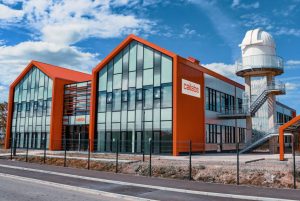How does atmospheric turbulence impact laser communication?
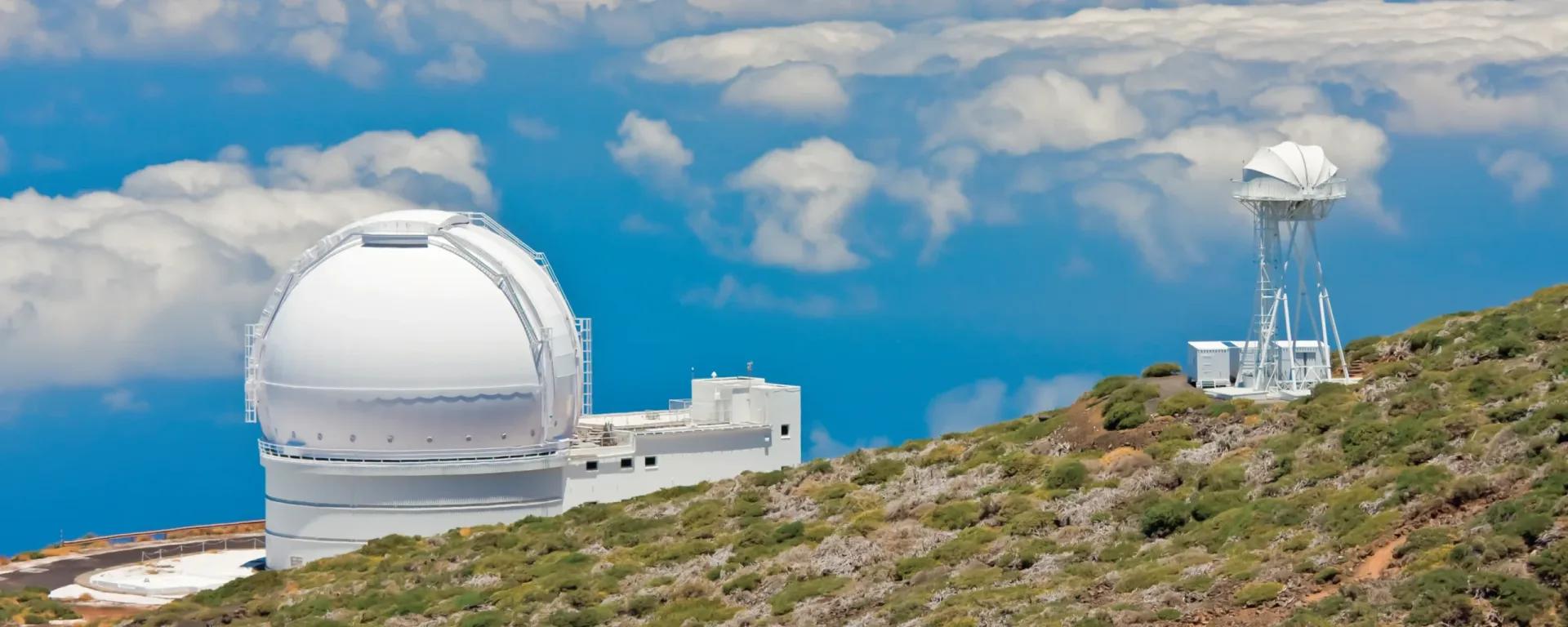
Spread secure information at the speed of light at very high speeds from a mobile, minimalist infrastructure. In sum, this is what enables free-space optical communications.

In many fields, from space communications to military forces to humanitarian emergencies, this technology enables very high-speed telecom networks to be deployed in areas that were previously inaccessible. Unfortunately, the large-scale development of these systems is limited by the influence of atmospheric disturbances. Advances in laser technologies and adaptive optics partly mitigate the influence of the atmosphere but are not suitable for all uses.
What are the new techniques that could make Laser Communication more accessible and reliable?
Laser communications
The advent of lasers in the 1980s led to a boom in optical telecommunications. When the most widespread networks are based on fiber technologies, the deployment of optical cables is not always relevant or even possible. Whether it is a matter of rapidly restoring communication in disaster areas, exchanging information with vehicles or connecting several buildings in overcrowded metropolitan areas, free-space optical communication is the most viable solution.
Commonly referred to as FSO (for Free-Space Optical Communication or Laser Communication), this method of communication uses the propagation of light in air or a vacuum to transmit information. This approach has many advantages over competing technologies, which are mostly fiber and radio-frequency-based communications that are often complementary to FSO(1).
Firstly, optical technologies, whether fiber-based or not, have an unparalleled throughput capacity. In free space, a 10.45 km link was able to attain a speed of 13.16 Tb/s by the DLR teams (German Aerospace Center). Although these rates are still far from 10.16 Pb/s obtained over a fiber(2), they are nearly 300 times higher than other wireless technologies, such as radio frequency, in which the best long-distance links allow speeds of at most 6 Gb/s over a distance of 40 km(3).

© Deutsches Zentrum für Luft und Raumfahrt
Furthermore, spatially and spectrally located beams do not encroach on already allocated frequency bands. They do not generate bandwidth conflict, interference between sources nor do they require a license as is the case for radio frequencies. It is therefore possible to establish an ultra-fast connection between two points simply by installing a transmitter and an optical receiver. Two buildings can, for example, be connected in a secure way and have a very high speed (LAN connection) even if they are not connected by a fiber or fiber network redundancy.
The terminals, as illustrated Figure 2, are mobile and deployable in a wide variety of configurations without the need for network infrastructures(4). Thus, in space, Airbus seeks to develop high-speed links between satellite constellations and ground stations(5). For the armed forces, this mobility, combined with the difficulty of intercepting invisible, very localized beams, makes it possible to establish secure local networks anywhere in the world as well as high-speed links with satellites.
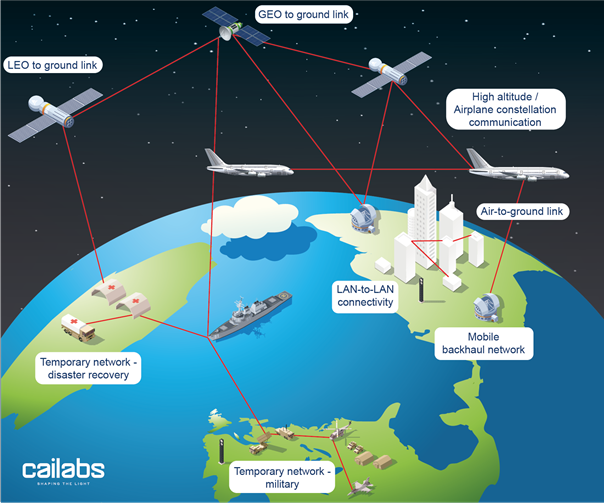
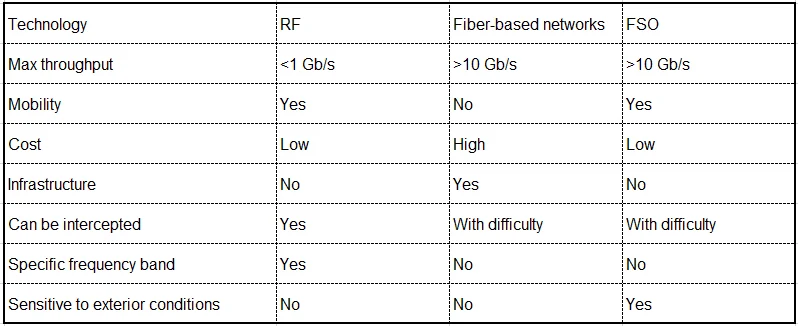
Atmospheric disturbances
The downside to FSO’s great flexibility lies in the propagation channel. As described in the reference book of Andrews and Phillips, terrestrial free space communications are subject to a major limiting factor: atmospheric disturbances(6). In addition to the obvious but marginal restrictions, such as the presence of objects that can block the propagation of the beam, many factors can attenuate the intensity of the signal.
This is particularly the case for smoke in a war or disaster zone, but also more commonly fog or rain. Being that the transmission data capacity is determined by the signal-to-noise ratio (SNR), and thus the intensity, these losses are highly detrimental. This is particularly the case for long-distance applications in which attenuation can be high.
Above all, the atmosphere is not a perfectly homogeneous medium. Slight differences in pressure, temperature or composition locally modify the refractive index of the air and deviate the different optical paths of the beam. The wavefront, that is to say the shape of an optical beam, is continuously and randomly modified during its propagation in the atmosphere as shown in Figure 4.
These disturbances affect the shape, quality (phase) and intensity of the light beam collected and degrade the quality of the link. Moreover, in order to be effectively detected, the light is generally collected in a standard telecom optical fiber, known as a single-mode fiber (SMF). This type of fiber is used extensively in the telecommunications industry.
It is compatible with a very wide variety of components such as sources, amplifiers, and detectors and is therefore, very technologically mature. Unfortunately, when the wavefront of the beam is disturbed, it may not couple as well in single-mode fibers, which causes further losses that degrade the quality of the signal.
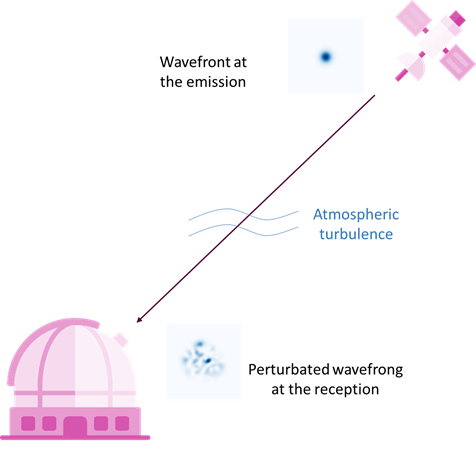
Taking it further…
Free-space laser communication is a great tool for transmitting information at very high speeds where the fiber is not easily deployable. Some digital giants such as Facebook and Google are already studying the possibility of widely diffusing the Internet in non-fiber-reinforced areas using these technologies(6). For example, a contract between Alphabet and the State of Andhra Pradesh in India has been signed to test this approach in the field(7).
However, in order to fully exploit the potential of FSO laser communication, it is essential that the effects of atmospheric disturbance be overcome. Without this, the reliability and quality of the transmission will be severely degraded. Different approaches already exist, including adaptive optics, a technique inspired by astronomy, but they are not always adapted or sufficient to reach very high speeds in all conditions.
New approaches, passive and compact, are emerging and could help overcome some technological barriers. Cailabs, specialized in beam shaping, is working on this issue and currently developing a product dedicated to free-space laser communications.
Bibliography
| (1) | M.-A. Khalighi et M. Uysal, «Survey on Free Space Optical Communication: A Communication Theory Perspective,» IEEE Communications Surveys & Tutorials, vol. 16, n° %14, pp. 2231-2258, 2014. Read more |
| (2) | D. Soma et al., «10.16-Peta-B/s Dense SDM/WDM Transmission Over 6-Mode 19-Core Fiber Across the C+L Band,» Journal of Lightwave Technology, vol. 36, n° %16, pp. 1362-1368, 2018. Read more |
| (3) | «Researchers Claim Record for Terrestrial Radio Transmission,» Microwave & RF, May 2016. Read more |
| (4) | Mynaric, «The Smaller, The Better,» 2018. Read more |
| (5) | Airbus, «SpaceDataHighway,» Read more |
| (6) | L. Andrew et R. Philips, Laser Beam Propagation Through Random Media, Washington: SPIE Press, 2005. Read more |
| (7) | M. Merky, «Alphabet : un accès à Internet grâce à la technologie laser» 23 12 2017. Read more |

By David Allioux
David Allioux, who holds a Ph.D. in optics from the University of Lyon, joined Cailabs in 2018. As a project and product manager, he is in charge of the development and integration of telecommunication R&D solutions. He also brings his expertise to develop and commercialize the laser communication product line.
